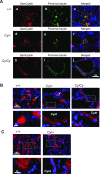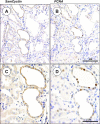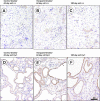Polycystic kidney disease in Han:SPRD Cy rats is associated with elevated expression and mislocalization of SamCystin
- PMID: 20719982
- PMCID: PMC2980402
- DOI: 10.1152/ajprenal.00504.2009
Polycystic kidney disease in Han:SPRD Cy rats is associated with elevated expression and mislocalization of SamCystin
Abstract
Polycystic kidney disease (PKD) in Han:SPRD Cy rats is caused by a missense mutation in Anks6 (also called Pkdr1), leading to an R823W substitution in SamCystin, a protein that contains ankyrin repeats and a sterile alpha motif (SAM). The cellular function of SamCystin and the role of the Cy (R823W) mutation in cyst formation are unknown. In normal SPRD rats, SamCystin was found to be expressed in proximal tubules and glomeruli; protein expression was highest at 7 days of age and declined by ∼50-60% at 45-84 days of age. In Cy/+ and Cy/Cy kidneys, expression of SamCystin was lower than in +/+ kidneys at 3 and 7 days but became elevated at 21 days. Immunohistochemical analysis revealed that SamCystin was distributed on the brush border of proximal tubules in normal rat kidneys. In Cy/+ kidneys, there were robust SamCystin staining in cyst-lining epithelial cells and loss of apical localization, and increased number of PCNA-positive cells in cyst-lining epithelia. Verapamil, an L-type Ca(2+) channel blocker, accelerated PKD progression in this model and caused a further increase in the expression and abnormal distribution of SamCystin. We conclude that aberrant expression and mislocalization of R823W SamCystin lead to increased cell proliferation and renal cyst formation.
Figures







References
-
- Arnaout MA. Molecular genetics and pathogenesis of autosomal dominant polycystic kidney disease. Annu Rev Med 52: 93–123, 2001. - PubMed
-
- Bihoreau MT, Ceccherini I, Browne J, Kranzlin B, Romeo G, Lathrop GM, James MR, Gretz N. Location of the first genetic locus, PKDr1, controlling autosomal dominant polycystic kidney disease in Han:SPRD cy/+ rat. Hum Mol Genet 6: 609–613, 1997. - PubMed
-
- Brown JH, Bihoreau MT, Hoffmann S, Kranzlin B, Tychinskaya I, Obermuller N, Podlich D, Boehn SN, Kaisaki PJ, Megel N, Danoy P, Copley RR, Broxholme J, Witzgall R, Lathrop M, Gretz N, Gauguier D. Missense mutation in sterile alpha motif of novel protein SamCystin is associated with polycystic kidney disease in (cy/+) rat. J Am Soc Nephrol 16: 3517–3526, 2005. - PubMed
-
- Cogswell C, Price SJ, Hou X, Guay-Woodford LM, Flaherty L, Bryda EC. Positional cloning of jcpk/bpk locus of the mouse. Mamm Genome 14: 242–249, 2003. - PubMed
-
- Cowley BD., Jr Calcium, cyclic AMP, and MAP kinases: dysregulation in polycystic kidney disease. Kidney Int 73: 251–253; discussion 269, 2008. - PubMed
Publication types
MeSH terms
Substances
Grants and funding
LinkOut - more resources
Full Text Sources
Miscellaneous

